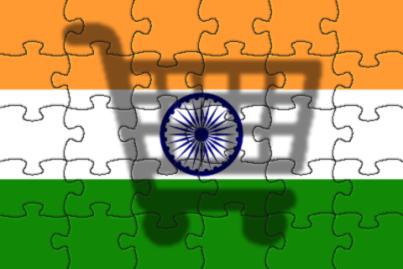According to an Assocham-PricewaterhouseCoopers study, India is at the cusp of an e-commerce revolution. Accelerating internet access, staggering penetration of mobile phones and robust investment have driven the growth of this industry, and if current projections are anything to go by, India is on route to becoming the world’s fastest growing e-commerce market.
India’s e-commerce industry is likely to clock a compounded annual growth rate (CAGR) of 35 per cent and cross the $100-billion mark over the next five years, from $17 billion at present. The e-commerce sector is estimated to see a 72 per cent jump in the average annual spend on online purchases per individual in 2016, from the current level of 65 per cent, the study said.

In contrast, shopping malls are suffering from lesser footfalls leading to around 25 per cent vacancy rate, along with a 30 per cent drop in rentals in the last one year.
With improvement in infrastructure such as logistics, broadband and internet-ready devices, there is likely to be a significant increase in the number of consumers making purchases online, the study said, predicting around 65 million consumers in India to buy online in 2015, as against around 40 million in 2014.
The greater adoption of Internet and smartphones is the biggest driver of e-commerce in India. Internet penetration is rapidly increasing with around 300 million users in 2014. The smartphone is steadily growing and consists of 35% of the overall mobile phones market in the country.
The success rate of some of the technologies, such as cloud technology, mobile apps and digital advertisements, is directly connected to the success of e-commerce. Most e-tailers are depending on cloud technology for its flexibility, scalability, availability, and efficiency. With more than 235 million people in India accessing internet through mobile devices, e-tailers are focusing their efforts on mobile app penetration across the country. The mobile apps are helping to reach more customers, even in remote areas. The revenue coming from mobile app is also on the rise e.g., 50% for Flipkart and 70% for Quikr. The digital advertisement industry is growing rapidly with growth in digital communication devices.
According to the Deloitte India TMT Prediction, 2015, a new category of service, (handyman, delivery, healthcare, repairing) that touches the daily lives of the consumer, would play a pivotal role in the growth of e/m-commerce in the coming years.
Customer would be the king for the e-retailers. Leading telecom operators are working with mobile app vendors to improve the overall network performance on smartphones which would help better customer experience in terms of network speed and performance of mobile apps.
There are about 930 million wireless subscribers in India. The number of internet users among them is growing rapidly. This rapid spread of mobile internet could unlock a significant market beyond the Tier 1 cities for the online retail segment. Undoubtedly, mobile retailing is expected to continue to grow aggressively.
The e-Marketplaces are growing significantly. These provide a technology platform for sellers to participate and a trusted environment to scale up rapidly. With e-tailers disrupting the traditional shopping, every retailer is looking for an online and offline presence either through omni-channel or through marketplace e-tailers.
According to Euromonitor, store-based retail sales will increase 10% in the next five years, while online sales are projected to increase by 40% in India. The retailers have started to work on their omni-channel sales strategy. For example, Future Group inked an exclusive deal with Amazon while Tata Group owned Croma partnered with Snapdeal to sell private brands online. While the reverse is also true with companies like FirstCry opening physical stores later to complement online sales. Just as physical stores are seeking to get into the online and mobile space, the time is also right for online stores to make their presence felt in the offline space. Organized retailers will need to invest significantly more to compete with the e-commerce giants.
